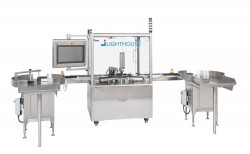Laser-based headspace for 100% container closure integrity inspection
Container closure integrity (CCI) plays an important role in maintaining the sterility and stability of parenteral products. LIGHTHOUSE has analyzed CCI inspection data of commercial freeze-dried product vials from sterile facilities around the world. The data set of 15 million lyo vials shows an average CCI failure rate similar to that of ampoules (a few tenths of a percent - for more details, watch the Screencasts at the bottom of this page). The risk for container closure failure in the lyo process is part of the reason for new regulations and increased attention from inspectors to this topic in the past several years.
Loss of container closure integrity can occur due to component defects (cracks in glass, out-of-specification vial/stopper dimensions or improper vial/stopper combinations) or process defects (displaced stoppers prior to capping, misaligned tooling, rough handling). Laser-based headspace inspection enables automated in-line leak detection by monitoring changes in headspace gas composition or changes in total headspace pressure. Leak defects will allow gas flow from outside a container into the headspace. If a container is initially processed with a modified atmosphere in the headspace (purged with an inert gas or evacuated to a reduced pressure), then a total pressure rise or oxygen partial pressure rise can be detected and correlated to a leak rate. LIGHTHOUSE sensors use spectroscopic techniques to make a rapid non-destructive analytical measurement of the headspace conditions.
In addition to a potential sterility risk, product stability can be compromised by a loss of container closure integrity. Gas ingress, particularly of reactive atmospheric molecules such as oxygen and moisture, can impact product stability and reduce potency through reactions with active ingredients and excipients. LIGHTHOUSE sensors quantitatively measure oxygen and moisture levels inside the product container. For products that are oxygen- or moisture-sensitive, this enables a verification that product is within specification.
Please contact us to take advantage of our experience and expertise in 100% container closure integrity inspection of sterile vials.
Presentation “100% lyo product CCI inspection benchmarking data”

